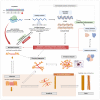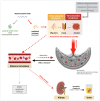Protein Misfolding in Pregnancy: Current Insights, Potential Mechanisms, and Implications for the Pathogenesis of Preeclampsia
- PMID: 38338354
- PMCID: PMC10856193
- DOI: 10.3390/molecules29030610
Protein Misfolding in Pregnancy: Current Insights, Potential Mechanisms, and Implications for the Pathogenesis of Preeclampsia
Abstract
Protein misfolding disorders are a group of diseases characterized by supra-physiologic accumulation and aggregation of pathogenic proteoforms resulting from improper protein folding and/or insufficiency in clearance mechanisms. Although these processes have been historically linked to neurodegenerative disorders, such as Alzheimer's disease, evidence linking protein misfolding to other pathologies continues to emerge. Indeed, the deposition of toxic protein aggregates in the form of oligomers or large amyloid fibrils has been linked to type 2 diabetes, various types of cancer, and, in more recent years, to preeclampsia, a life-threatening pregnancy-specific disorder. While extensive physiological mechanisms are in place to maintain proteostasis, processes, such as aging, genetic factors, or environmental stress in the form of hypoxia, nutrient deprivation or xenobiotic exposures can induce failure in these systems. As such, pregnancy, a natural physical state that already places the maternal body under significant physiological stress, creates an environment with a lower threshold for aberrant aggregation. In this review, we set out to discuss current evidence of protein misfolding in pregnancy and potential mechanisms supporting a key role for this process in preeclampsia pathogenesis. Improving our understanding of this emerging pathophysiological process in preeclampsia can lead to vital discoveries that can be harnessed to create better diagnoses and treatment modalities for the disorder.
Keywords: Alzheimer’s disease; amyloid-β; preeclampsia; protein misfolding; tau; transthyretin.
Conflict of interest statement
IAB is named as the co-inventor on patents claiming protein misfolding, congophilia, and conformational-dependent immunoreactivity as diagnostic and therapeutic targets for preeclampsia. The patents have been licensed for commercialization to private entities. BMF has no conflicts of interest to declare.
Figures




Similar articles
-
Human pregnancy zone protein stabilizes misfolded proteins including preeclampsia- and Alzheimer's-associated amyloid beta peptide.Proc Natl Acad Sci U S A. 2019 Mar 26;116(13):6101-6110. doi: 10.1073/pnas.1817298116. Epub 2019 Mar 8. Proc Natl Acad Sci U S A. 2019. PMID: 30850528 Free PMC article.
-
Protein misfolding, congophilia, oligomerization, and defective amyloid processing in preeclampsia.Sci Transl Med. 2014 Jul 16;6(245):245ra92. doi: 10.1126/scitranslmed.3008808. Sci Transl Med. 2014. PMID: 25031267
-
Protein Misfolding during Pregnancy: New Approaches to Preeclampsia Diagnostics.Int J Mol Sci. 2019 Dec 7;20(24):6183. doi: 10.3390/ijms20246183. Int J Mol Sci. 2019. PMID: 31817906 Free PMC article. Review.
-
Characterization of Pairs of Toxic and Nontoxic Misfolded Protein Oligomers Elucidates the Structural Determinants of Oligomer Toxicity in Protein Misfolding Diseases.Acc Chem Res. 2023 Jun 20;56(12):1395-1405. doi: 10.1021/acs.accounts.3c00045. Epub 2023 Apr 18. Acc Chem Res. 2023. PMID: 37071750 Free PMC article.
-
The Single Toxin Origin of Alzheimer's Disease and Other Neurodegenerative Disorders Enables Targeted Approach to Treatment and Prevention.Int J Mol Sci. 2024 Feb 27;25(5):2727. doi: 10.3390/ijms25052727. Int J Mol Sci. 2024. PMID: 38473975 Free PMC article. Review.
Cited by
-
Optimization of the Search for Neuroprotectors among Bioflavonoids.Pharmaceuticals (Basel). 2024 Jul 3;17(7):877. doi: 10.3390/ph17070877. Pharmaceuticals (Basel). 2024. PMID: 39065728 Free PMC article.
References
Publication types
MeSH terms
Substances
Grants and funding
LinkOut - more resources
Full Text Sources
Medical
Research Materials

